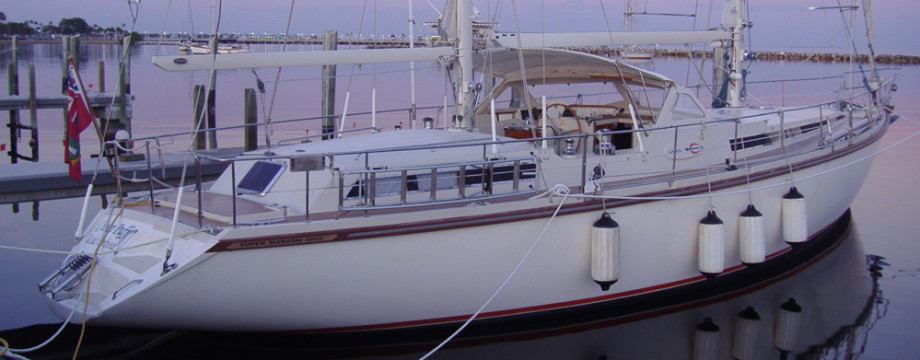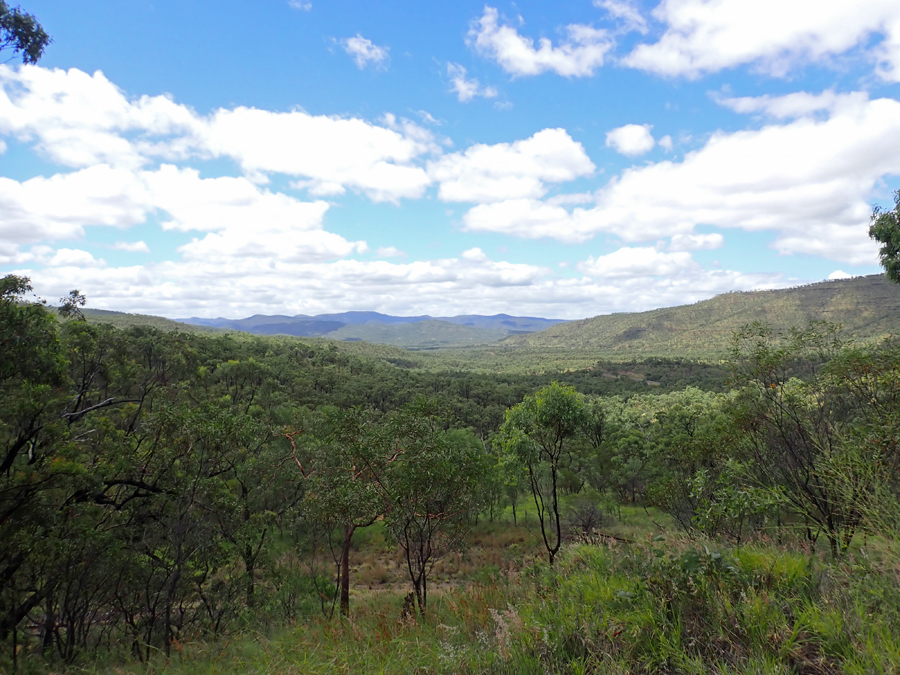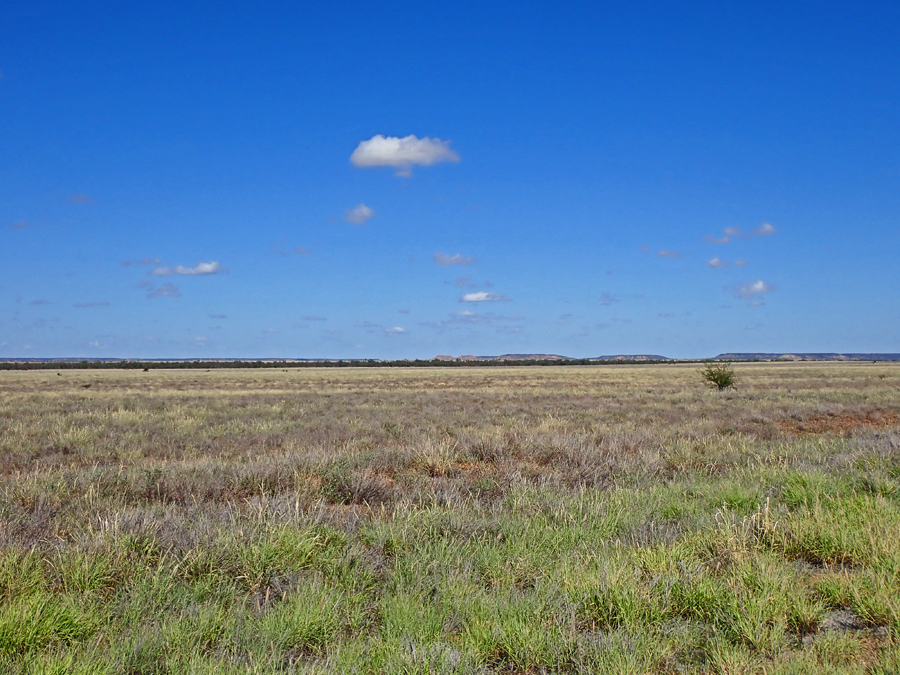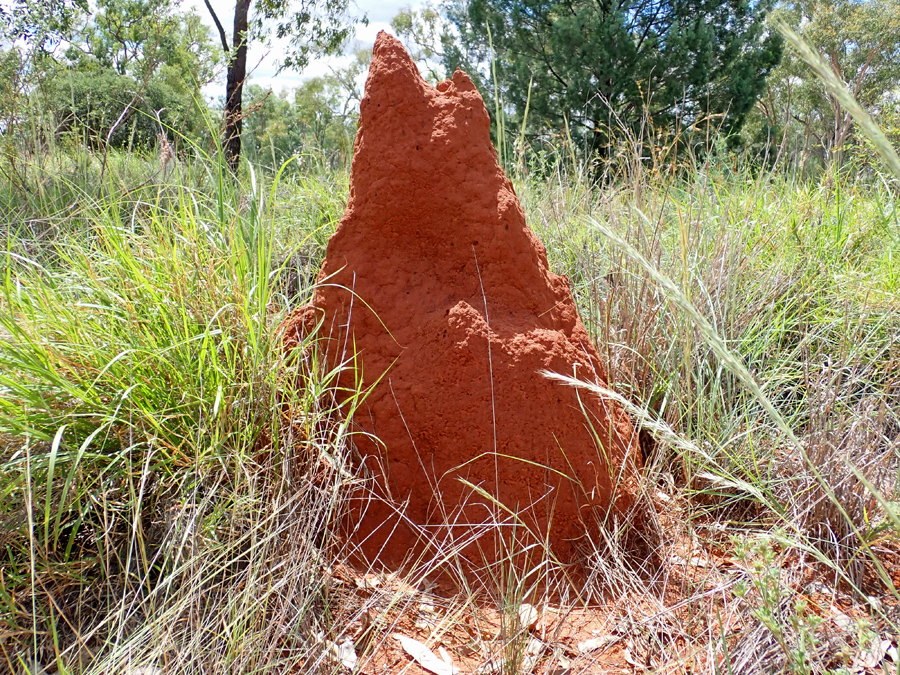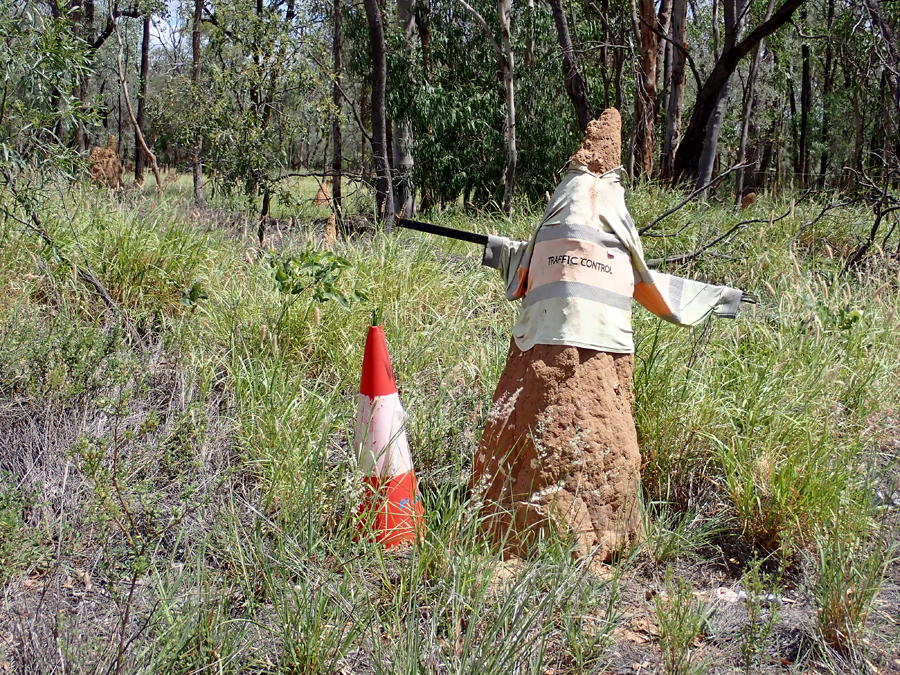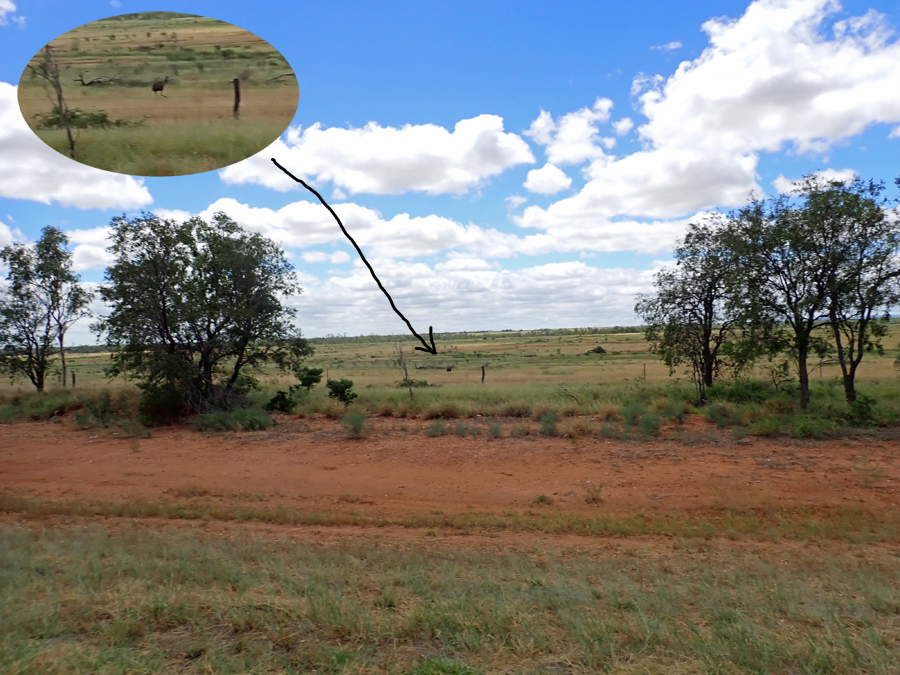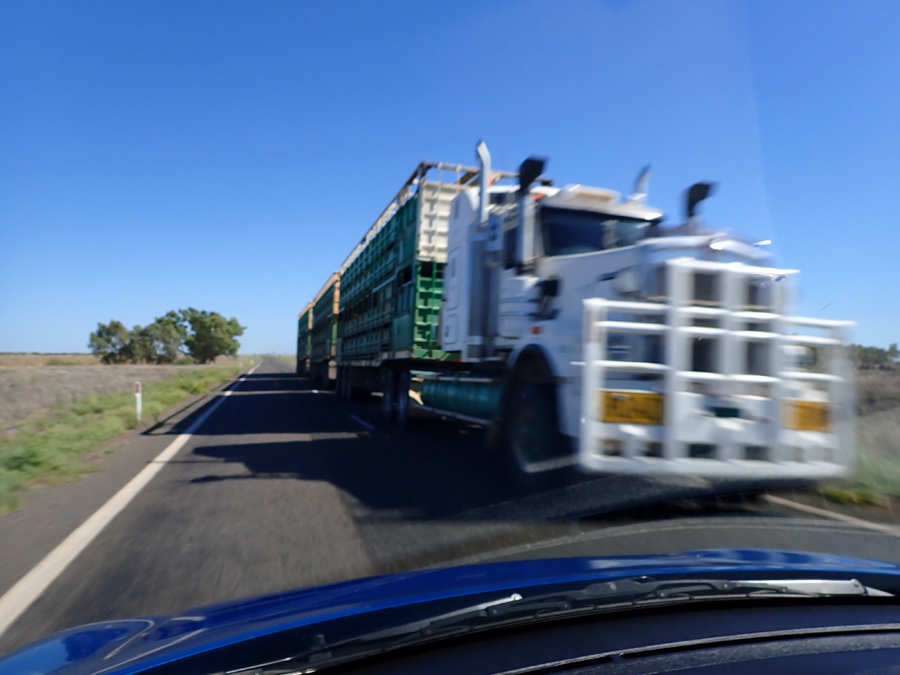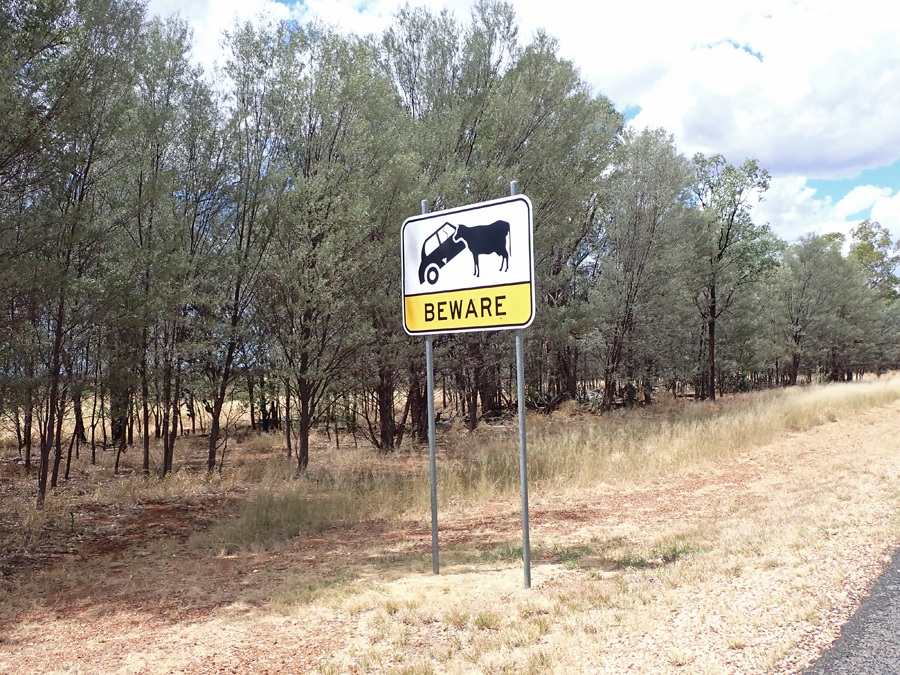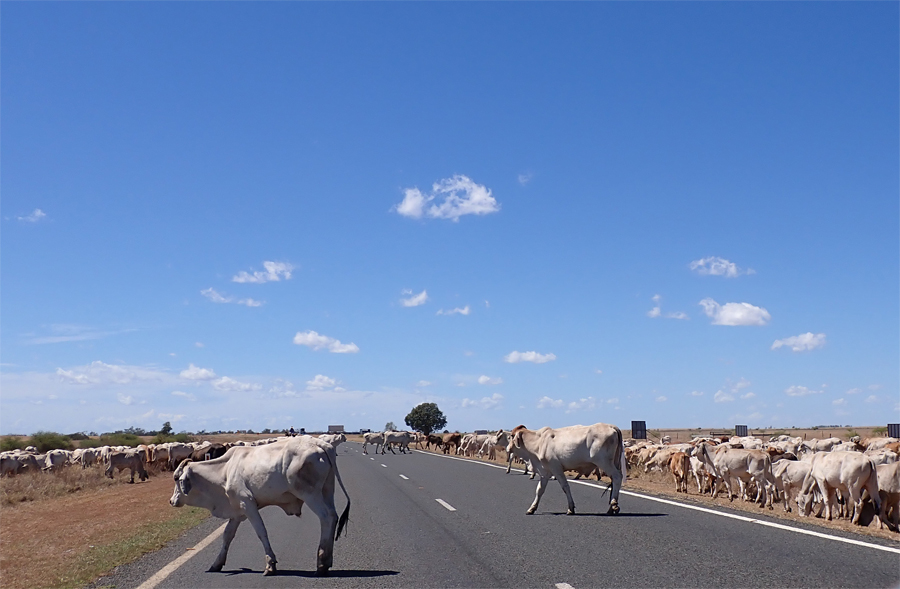We went to the outback. And, I’m not talking about The Outback Steakhouse. On the subject of the restaurant chain, after being in Australia now for a couple of months, I can honestly tell you there is nothing Australian about that chain. There are no “Bloomin’ Onions” or “Aussie Fries”. And, certainly no Foster’s beer. These are all things dreamed up by marketing people wondering how much wool can they pull over the eyes of the American public.
On this trip, we decided to head west. Why? Wayne, a contractor on the boat got chatting with us. He is near retirement and was talking about moving to a small town in the Australian outback. One of the towns he mentioned was Longreach. Longreach’s claim to fame is the “Gateway to the Outback”. Wayne said he can’t wait to leave the hustle and bustle of the city for the peace and quiet of a town like this.
As he told us about Longreach, we decided it would make a fun side trip for us. There are a couple of interesting things to do in Longreach. Keep reading and you’ll find out what they are.
There are a few things in Australia that are really growing on us. We find most people are generally nice. Australians often start conversations and can be chatty. They also tend to be polite and say please and thank you. Things might be different in the big cities, but where we keep the boat and during our travels, we find this to be true.
When traveling, we notice there is no trash by the side of the road, anywhere. This is true for the townships as well as the countryside. A “Keep It Clean” campaign in Australia began in the early 1990s. It was part of broader efforts to address littering and pollution in the country. The campaign aimed to raise awareness about the environmental impact of littering and promote responsible waste disposal practices among Australians.
While the specific campaign name and branding have evolved over time, the core message of reducing litter and protecting Australia’s natural beauty has remained a focus. It’s working. Australia is the cleanest place we’ve visited, so far.
A couple of days ago, we drove for about eight hours heading to the outback. I noticed a KFC box on the side of the road and realized this was the only piece of trash I’d seen all day.
Another thing we’ve come to quickly appreciate about Australian people is their sense of humor and quirkiness. For instance, telling us to watch out for drop bears when we say we are going for a hike. They keep us on our toes. Is someone seriously trying to help or poking fun?
“Drop bears” are a part of Australian folklore and are often used to prank or scare tourists. They are typically described as large, carnivorous koala-like creatures that drop from trees to attack unsuspecting victims. The story goes that drop bears lurk in the branches of trees and, when a person walks underneath, they suddenly fall on them, causing harm or fear.
Here is one of those only in Australia things. As we are driving west into the outback the trees are starting to disappear and we both sort of looked over and say, what the heck! We couldn’t believe our eyes. And, when we did realize the eyes were truthful we both had so many questions. Do people in these small towns honestly have nothing better to do than decorate termite mounds?
We noticed a termite mound wearing a Santa cap. Okay, this is just a one-off, right? Something left over from the holidays. A person having a bit of a laugh. Then, we see another one wearing a tee-shirt. And, then another one. And, another one. Time to get on the Google machine (can’t believe we have bars and internet out in the middle of nowhere).
Apparently, decorating termite mounds is a thing. According to Google, in some regions of Australia, it is a bit of a thing. So, when you next plan your visit to the land down under, make sure you plan enough time to dress the occasional termite mound. But, be careful.
I bet you are thinking that I’m going to tell you how Australia has termites that will kill you, right? Nah, it’s worse than that. Some Aboriginal groups in Australia traditionally believe that destroying or knocking over a mound will cause diarrhea. This belief is part of their deep spiritual connection with the land and nature. We also read that in some Aboriginal traditions, placing an item belonging to somebody else on a mound can cause harm or illness to that person. This probably explains the picture of the mound with a traffic cop’s jacket.
In Australia they have Cathedral Termite Mounds (Nasutitermes triodiae). These can grow over 8 meters (26 feet) tall, making them some of the largest in the world. While we weren’t in the right area for the massive ones, the sheer number of mounds we saw was impressive. We saw hundreds, if not, thousands of mounds about a meter (three feet) tall for as far as the eye could see. Then, as quickly as they arrived on our journey, they were gone.
On a bit of a side note here, when we found termites in our home in the USA, I did a fair amount of reading about them. One of the things I learned is the US pest control companies will try to scare the bejesus out of you. They paint a picture of your house being eaten up within a couple of days and collapsing. This just isn’t true. One of the things I learned back then is Australia is the termite capital of the world. As I write this sentence, I’m amazed they don’t have termites that will kill you. Everything in Australia is trying to kill you.
I also learned, because of the vast amount of termites here, most homes are built using a method eliminating wood-to-soil contact, which is a primary entry point for termites. In addition, having a trench around the home filled with playsand (very fine sand) will prevent termites from entering the house to munch on wood. Termites live in nests under and above ground. They dig tunnels or make tubes to commute to their food source, wood. They cannot tunnel through play sand since the fineness causes the tunnel to collapse. Also, if a metal barrier is placed between the concrete slab and the timber used in a home, the termites can’t penetrate this either. It is entirely possible to protect a home without the use of chemicals.
In Australia, many homes are built with natural barriers to termites so the need for pest control chemicals is lessened a great extent. They use the method I have already mentioned as well as other natural barriers. So, why don’t builders in the USA build houses using these known natural termite deterrents? The answer is simple. It cost a little extra money.
A few posts ago, I mentioned we had a couple of items on our list. We wanted to see kangaroos and koala bears in the wild. Seeing kangaroos has a checkmark by it. We have yet to see a koala and are still looking at eucalyptus trees closely as we travel. One of our Aussie friends, over a couple of beers, was kidding with us and tried to convince me they are now extinct. See what I mean about the Australians and their sense of humor.
One thing we didn’t have on the list that should have been was seeing an emu. If it had’ve been on the list, it would also have a checkmark now. We saw emus. How cool is that? We quickly pulled over to the side of the road. At one point, they were pretty close to us, and we got a good look. But, the moment we started to move about to grab a camera, they took off. Here is our Loch Ness Monster looking picture of an emu.
Let’s talk about the roads for a bit. The path we took had “bitumen” roads. Bitumen is an Australian slang term which is a colloquial way of referring to a tarmac road or asphalt road. Many of the roads can turn to dirt paths so, it pays to put the Google guy on the route to take a look before selecting the route. When we first learned this term from one of our Aussie friends, I asked why he kept referring to roads we might take as bitching roads.
We tended to stay on the main roads. This meant we shared the road with “road trains”. These are massive trucks pulling up to three trailers. They can be up to 53.5 meters (175 feet). This configuration is common in Australia and is often used for transporting large amounts of freight over long distances, particularly in remote or rural areas. If you can believe it, these are the smaller trucks. As a trucker gets deeper into the outback, they can add more trailers depending on the state and regional rules. This would mean four or five trailers.
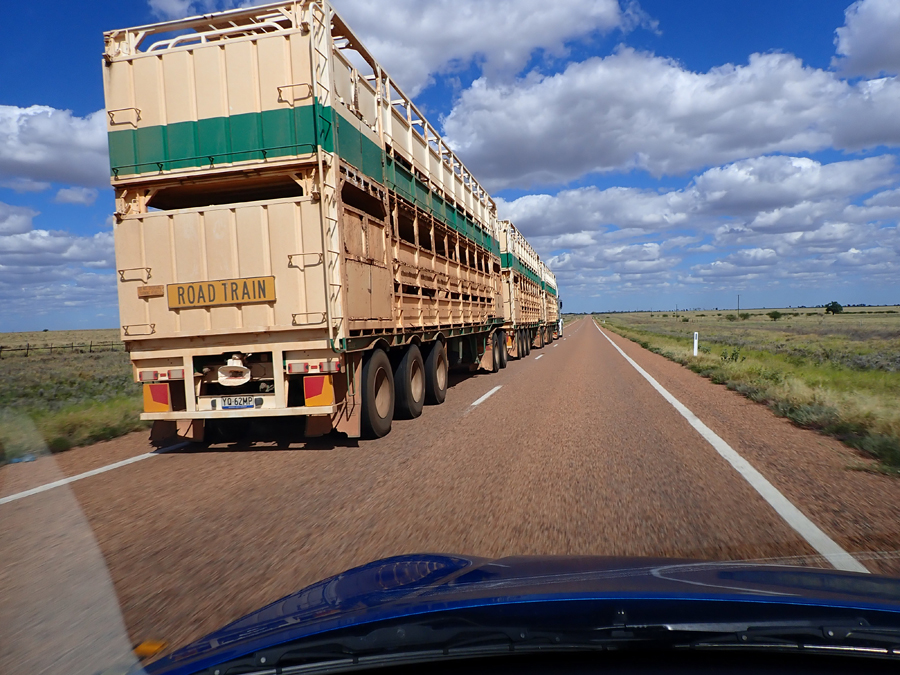
A double-decker cattle truck with three trailers. Good job we can see all the way to the horizon when passing this – it takes a while. BTW – you don’t want to spend too much time behind these for obvious reasons – we had to use our wipers and it wasn’t raining. LOL
The outback roads are not the best. They are bumpy. Even the tarmac roads can make you feel like you are about to lose pieces of the car. Just about everyone living in the outback drives a big pickup truck or SUV. Many have extended air intakes to allow them to drive in deeper water. The road can flood quickly, and if you are in a small car like ours, you can become stuck waiting for the water to recede before continuing on the journey. Signs indicate if the road is open or closed ahead.
Dave, a member of our “Friday” group, told us to be aware of rain and flooded roads. He said he was stuck in a small town for 5 days waiting for a road to re-open. We were fortunate and had exactly zero raindrops for the week we traveled.
We took our InReach with us. As you can imagine, cell phone coverage can be rather spotty in the middle of nowhere. InReach is a portable satellite communication device that can be used in emergencies. So long as it sees the sky, it can communicate. We purchased this to use aboard the boat, but it has come in handy in very remote areas.
A lot of the area we traveled reminded Cindy of Texas. “Big sky” is the best way I ever heard to describe Texas and the same is true for the outback. There are more people in the state of Texas, USA (31.2m) than the entire country of Australia (27.2m). So, it is like being in Texas but without any people.
We would often drive for 30 or 45 minutes without having a vehicle pass us going in the opposite direction. I set the cruise control on the car for 110 kph (68 mph). This is the speed limit of the outback roads which means you can get nicely airborne on the bumps that tend to sneak up. I am not kidding when I say this next part. I often set the cruise control of the car and never touched the gas or brake for an hour, or more. If ever there was a place for self-driving cars, this would be it. Of course, they wouldn’t sell very many due to the sparse population.
How far into the outback did we get? Well, we got inland from the coast about 700 km (435 miles) as the crow flies (the drive was much longer since we had to go north to get a road to take us west). To reach the Indian Ocean on the other side, we’d need to drive another 3100 km (1926 miles). In other words, we barely made it 1/5th of the way across Australia and merely stuck our toes into the outback.
The flies! OMG! Nobody told us about the flies. Anytime we stepped outside, we were instantly covered in flies. And, it gets worse. The flies go for any part of your body with moisture. Meaning, they go for your eyes and up the nose. They get behind your glasses or sunglasses. And, if you happen to open your mouth to speak, guess what?
In the place where we stayed, they offered mesh for tourist to place over their hats. https://m.media-amazon.com/images/I/81ZoZ66O7JL.jpg We didn’t buy any but if we had stayed any longer, it would have been a “must have”. Getting into the car was like a mating dance. Each of us was waving our arms about wildly to shoo off the flies and quickly opening the door and getting in with as few as possible still attached to us. Once in the car, they basically baked alive from the heat on the windows. Yeah, it’s pretty hot in the outback.
Coming up in Part II, we did some pretty cool stuff and visited a tiny outback town.
